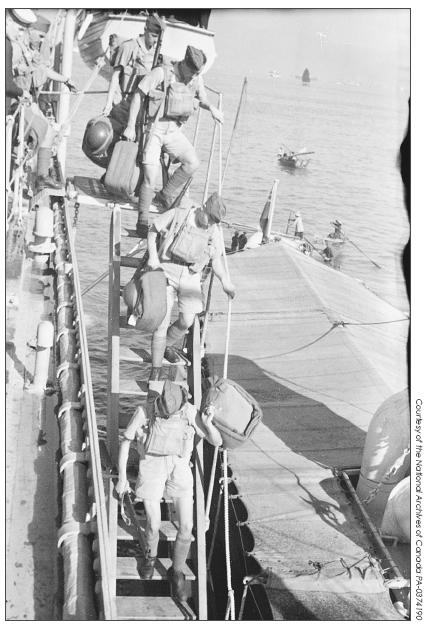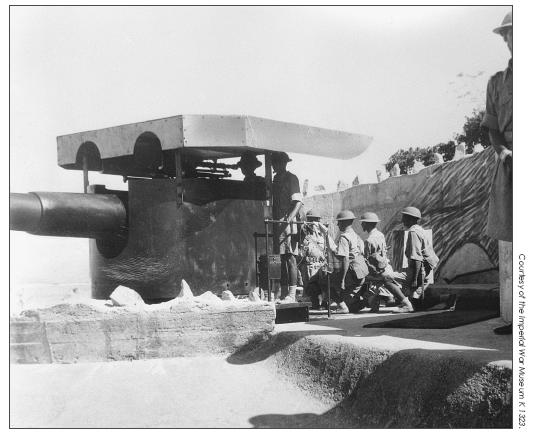Sergeant Gander (7 page)
The Royal Rifle's “C” Company infantrymen preparing to disembark from the
Prince Rob
â
ert
, November 16, 1941.
had our mascot ⦠our big, black dog leading the march. He walked right up the street there, as proud as could be.”
5
Rifleman Ken Cambon remembers a similarly grand reception, “Our two battalions marched down Nathan Road steel-helmeted and obviously invincible. The main street of Kowloon was lined by cheering crowds waving small Union Jacks.”
6
The sight of the jaunty Canadians led by their canine mascot seemed to give a sense of security and hope to a population who had been anxiously watching their borders, ever fearful of Japanese intentions.
Indeed, one Dutch construction engineer, Jan Henrik, who was in Hong Kong on business, noted, “Somehow, their arrival apparently clinched Hong Kong's complacency. In 1939, nobody had thought Hong Kong could be defended successfully. After the arrival of a few thousand Canadians, everybody felt that the Crown Colony could and would be defended successfully. It was a psychological miracle I am unable to explain.”
7

Royal Rifles disembarking HMCS
Prince Robert
, Hong Kong, Noâvember 16, 1941.
The arrival of the Canadians brought the number of Hong Kong defenders to over 14,000. However, as that number included nursing sisters, the St. John Ambulance Brigade, and the Hong Kong Mule Corps, a transport unit consisting of three officers, 250 men, and ninety mules, the actual number of infantrymen was about 5,422. The remainder of the force was comprised of the Royal Artillery, the Royal Engineers, Hong Kong Volunteer Defence Corps, and the Royal Navy.
8
Prior to that, the Hong Kong forces, under the command of General C.M.

Canadian soldiers trainâing in the hills of Hong Kong just prior to the Japanese invaâsion, December 1941.
Maltby (although the governor, Mark Young, held the title commander-in-chief, the garrison was commanded by Maltby), consisted of only four Regular Army battalions: 2nd Battalion Royal Scots, 1st Battalion the Middlesex Regiment, 5/7 Rajputs, and the 2/14 Punjabis.
9
For a while things were peaceful, and the Canadians spent their time familiarizing themselves with the island's terrain and its defences. Rifleman John Beebe explains:
We lost no time in getting down to work, taking up our posts on guard duty at the permanent dugouts and shelters. These were our future battle stations and we got familiar with the lay of the land during our three day sessions on guard duty. In the following two weeks we got to know the place even better and to like it very well. We drilled hard every morning for two or three hours. We had our own rifles and Brens and although our heavy equipment never arrived, there was plenty of British heavy equipment and we were well trained in its use.
10
Gander also familiarized himself with the terrain as he accompanied his fellow soldiers on patrol each day. Alongside Fred Kelly, Gander would perform guard duty, occasionally sneaking off for a nap in the shade. During the evenings, in an effort to escape the heat, Gander would sleep in the pillboxes with the men.
The Hong Kong garârison was supported by a much reduced Royal Navy and Royal Air Force presâence. The Navy had only one destroyer, eight moâtor torpedo boats, four river gunboats, a couple of minelayers, and some auxilâiary patrol vessels on hand. The air force had only three Vickers Vildebeestes (torâpedo bombers) and two Supermarine Walrus amâphibians at Kai Tek Airport. Eighteen fixed coastal guns, pill boxes (defensive bunâCanadiankers from which soldiers can defend against enemy attack), minefields, and barbed wire entanglements ringed the island, all put in place to deter an enemy attack. The southern part of the island was the heaviest fortified in expectation of an attack from the sea. The north side of the island, facing the mainland, and Lye Mun Passage (which is only about 412 metres across at its narrowest point) were less fortified.

Canadian Bren-gun team on a training exercise in the Hong Kong hills prior to the Japanese invaâsion, December 1941.
The precarious state of the island's defensive strength was not lost on Winnipeg Grenadier Private Wilf Lynch, who claimed:

An Indian gun crew manning one of Hong Kong's 9.2 inch coastal defence guns just prior to the Japanese invasion.
The minute I got off the boat in Hong Kong, I realized that if the
Japanese attacked, they'd wipe us out. We've got no air force, no
navy, no place to go, I told my pals. The Japs can back us up to
the sea and even the best goddamned swimmer in the Grenadiers
couldn't make it all the way back home to Canada.
11
Despite concerns about the colony's defences, the first several weeks in Hong Kong proved to be quite satisfactory for the Canadians. The Sham Shui Po Barracks, located on the northwest side of Kowloon, were hospitable. Company Quarter Master Sergeant M.S. Standish wrote in a letter home, dated November 20, 1941:
⦠you can't imagine the barracks ⦠they are simply beautiful â¦
all made of cement with gardens and grass ⦠you can eat off the
sidewalks. I have a hut of my own to sleep in and cook in, and a
Chinese boy to look after me. He shines my boots, makes my bed
and generally makes himself useful, all for two dollars a week â¦
he's a millionaire at two dollars a week! A man works here at 20
cents a day Hong Kong money and that in Canadian money is
less than 6 cents.
12
As noted earlier, European and Canadian attitudes towards Hong Kong's native Chinese population and the Japanese enemy contained decidedly racist overtones. In wartime it was common practice to actively use negative stereotyping against the enemy to bolster morale among the soldiers who were likely to come face to face with them in combat. They viewed the Japanese as inferior soldiers, a perception that seemingly was largely due to the shape of their eyes. The Allied soldiers were told by their commanders that the Japanese had poor eyesight, and that due to their optical weakness they were not able to fight at night, could not shoot weapons accurately, and that their pilots would not be able to drop their bombs on target.
13
The Chinese civilians, who made up the majority of Hong Kong's population, fared little better in the eyes of Hong Kong's defensive forces. A British officer told Winnipeg Grenadier Ike Friesen a joke
13
that was making the rounds that clearly demonstrated the use of overt racist propanganda to diminish the value of the Chinese people as human beings.
Gander soon developed his own negative attitude towards the Chinese. According to a story told by Sergeant George MacDonell, the day that the Royal Rifles arrived at Sham Shui Po Barracks “some Chinese tried to lure Gander to the fence, planning to have him for dinner, but Gander escaped after a struggle. After that, Gander lost his faith in the Chinese and would lie in ambush for them when they entered the barracks on business, to the extent that he had to be tied up in the guardroom.”
14
The Canadian soldiers encouraged Gander's dislike of Asian people. The Chinese civilians that the soldiers saw on a daily basis were the unfortunate targets of this effort. The local people were leery about passing Gander on the road when he did guard duty. Having never seen the massive Newfoundland breed of dog before, they probably found Gander a strange and scary sight! Fred Kelly would watch as the Chinese would attempt to go around the patrol and then would say, “Gander, go and get them.”
15
Gander would charge at them, never biting them, but intimidating them by circling and growling. This unfortunate victimization of the Chinese people may explain, in part, Gander's ferocious response to the Japanese.
By the fall of 1941, the Japanese looked as though they were preparing to move against Hong Kong. In late October they landed 20,000 extra troops in South China, and a Japanese transport stopped in Hong Kong waters was found to have a Japanese general and his staff on board. There was also a report of the Japanese having established a lookout station on one of the small islands off the coast of Hong Kong. On the morning of December 7, 1941, a Punjabi border patrol reported Japanese troop movements of over 20,000 soldiers. Maltby was concerned enough to put the entire Hong Kong garrison on alert.
16
General Maltby's plan for the defence of Hong Kong entailed dividing his forces into an Island Brigade and a Mainland Brigade. Brigadier Cedric Wallis

The initial dispoâsition of forces, December 8, 1941.
was put in charge of the Mainland Brigade responsible for the mainland section of the colony, including the Kowloon Penninsula and the New Territories. His force consisted of the 2nd Royal Scots, the 2/14 Punjabs, and the 5/7 Rajputs. They were each assigned equal portions of the Gin Drinker's Line, named after nearby Gin Drinkers Bay. This Line was a series of entrenchments protected by barbed wire, with concrete pillboxes reinforcing the line at various strategic points for defence. One of the Punjab companies was positioned for fighting forward of the Line, in the New Territories; their job was to delay attackers and complete demolition assignments before falling back to the Line. If the Gin Drinker's Line was compromised the troops were to render the dockyard and fuel supplies useless to the enemy by blowing them up. Then they were to pull back to the Devil's Peak, a mountain on the Kowloon Peninsula that was garrisoned by the British, enabling them to control the water passage between the mainland part of the colony, the New Territories and Kowloon, and Hong Kong Island. Once there, the troops were to await evacuation across the Lye Mun Passage to Hong Kong Island.
